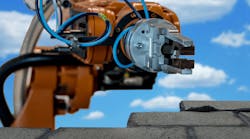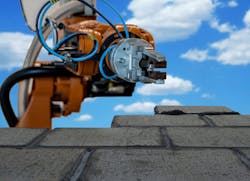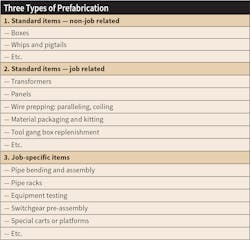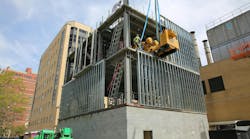Robots that do the work of an electrician on an actual job site? Flying drones that check on a project’s progress? Robots that lay bricks (see Photo). Is this for real? Technology is finally creating disruption in the construction arena. But how can this robot fantasy match up with today’s reality? This article provides a practical overview of what modeling and simulation may bring to electrical construction in the near future as well as presents a few examples of what is already in place on the robotics front.
Webster’s Dictionary defines a robot as “a device that automatically performs complicated, often repetitive tasks.” With this definition, let’s examine the potential for robots in electrical construction. Table 1 shows the types of tasks that could fit in this definition. The concern most electricians or technicians will have typically is two-fold:
1. What if I’m replaced by a machine?
2. Won’t quality decrease if I don’t perform the work myself?
These are both valid questions. However, if you look to other industries, such as farming, automotive, and aviation, robots had the opposite effect. In fact, adding automation helped more people become pilots, expanded the output and career opportunities in farming, and led to better quality vehicle output. However, robots aren’t always the solution. Whenever they’ve been used to try and replace human workers, they have failed because they cannot recreate the complex knowledge and interactions humans possess.
So rather than worrying about replacement, electricians and technicians should ask: “What are the repetitive or complicated tasks that I don’t like to do?” and then look for technology that could take that work off their plates. Prefabrication is a great place to start when looking for robotic support. MCA Inc. has identified three types of prefabrication (Table 2) that are prime candidates for automation and a good place for robots to enter the market for support.
So far, we have discussed the potential for robots and where they can bring a real benefit that will aid the workforce. Now, let’s look at some current real-life examples of robots at work.
Application 1: Supporting simple and repetitive tasks
Several simple and repetitive tasks can be done by machines. One example is wire stripping. In the trim stage of a project on a typical job site, for instance, there isn’t a single day that you wouldn’t see at least one electrician with his snips, preparing pigtails for his plugs and switches. “But it only takes two seconds,” he may say. Or, “I’m right here at my cart with everything I need, and I would hate to have to stop what I’m doing because some machine didn’t get them to me on time.” He is correct on both accounts, but such a machine can strip the ends of wire at a rate of up to 100 pieces per minute.
Application 2: Supporting non-installation tasks that don’t require skilled trade
Approximately 25% of the work on a typical job site requires electrician knowledge and application. About one-third of the work requires some technical or mechanical know-how, and the remainder doesn’t necessarily require a technical skill. All the work still needs to be planned, broken down, laid out, overseen, and quality-controlled by the electrician. However, some of the non-installation tasks, such as material handling, conduit bending, and job-site measurement and documentation, can be done with the aid of robots. Here are a few examples of how to use these machines in different applications.
As noted in an IEEE Spectrum robotics blog post, “AI Startup Using Robots and Lidar to Boost Productivity on Construction Sites,” Doxel is an unmanned robot that can handle most terrain and even climb stairs. While it maneuvers through the job sites, it scans/measures and reports back quality control and the productivity levels of thousands of line items for quicker reaction time on the job site. This robot operates with Lidar 2D scanning technology mixed with 3D sematic deep-learning algorithms. This artificial intelligence (AI) unit can identify shapes and sizes and — along with BIM or 3D modeling — can determine whether the item(s) were installed properly or not installed yet.
Drones
Whether you call them unmanned aerial vehicles (UAVs), small unmanned aerial systems (sUAS), or remotely piloted aircrafts (RPAs), drones have come down in cost while their capabilities continue to rise. As outlined in an ELECTRI International report, “Applications for Unmanned Aerial Vehicles in Electric Utility Construction,” drones can perform many types of optical inspections for electric utilities, including:
• Pole top inspections
• Distribution line inspections
• Land and facility inspections
• Infrared inspections
• Corona detection
Before drones, inspections were either at the mercy of ground field teams with the use of binoculars, which lack proper angle for a quality inspection to occur, or the expense of heavy equipment, such as bucket trucks or cranes, to do the same job at higher cost, at a higher risk, and at an increased time frame. On the utility power line front, they can offer reduction of safety risk by having the inspections and measurements on live infrastructure and equipment done without a human.
Atlas is a humanoid robot developed by Boston Dynamics, designed to walk, bend, and lift light objects (up to 24 pounds) as humans do. With Lidar technology and 3D Stereo vision, Atlas can scan and see objects in 3D, which allows it to perform simple, repetitive tasks. Atlas is also battery-powered, making it completely mobile and not tied down by any cords.
Application 3: Supporting complex tasks and reducing physical strain
Using BIM, positioning systems, and automatic or semiautomatic conduit bending equipment, we now see these converging technologies allow for complete conduit manipulation. This innovation will encourage processes to adapt and achieve significant savings in at least the following areas:
• Reduced material waste
• Improved labor effectiveness
• Reduced material handling costs
• Improved accuracy
• Better design and planning
• Fewer pieces of equipment to manage and maintain
• Reduced labor costs
• Improved safety
• Better labor balancing
Despite the seemingly insurmountable cost of full-scale, high-end conduit benders, cutters, and threaders, the industry is seeing increasingly consistent results that indicate a mid- to large-sized electrical contractor can see return on investment (ROI) in less than two years — and savings in the millions of dollars each year thereafter.
To increase productivity, most of the simpler tasks on a construction project can be done by automation. In addition, this approach will help to improve safety, resource usage and effectiveness of production, enabling improvement of human living standards. Nevertheless, every revolution needs multiple factors to come together. It is a mix of innovation, market need, and means of building assembly/production for this to happen. A single drone or new technology will not change the industry by itself. There needs to be a connection between the new technology and the means of production.
What does this mean for the construction industry? Robots and innovations together with identifying and breaking down the work process can help to change the way the work is completed in the field. In addition, improved levels of productivity will lead to lower cost of production and reduced competitiveness.
Dr. Perry Daneshgari is the president/CEO of MCA, Inc. He can be reached at [email protected]. Dr. Heather Moore is vice president of operations. She can be reached at [email protected]. Sonja Daneshgari is manager of field operations. She can be reached at [email protected].






